Shrikanth Narayanan
Signal Analysis and Interpretation Lab, University of Southern California, Information Science Institute, University of Southern California
Authors Should Label Their Own Documents
Dec 27, 2025Abstract:Third-party annotation is the status quo for labeling text, but egocentric information such as sentiment and belief can at best only be approximated by a third-person proxy. We introduce author labeling, an annotation technique where the writer of the document itself annotates the data at the moment of creation. We collaborate with a commercial chatbot with over 20,000 users to deploy an author labeling annotation system. This system identifies task-relevant queries, generates on-the-fly labeling questions, and records authors' answers in real time. We train and deploy an online-learning model architecture for product recommendation with author-labeled data to improve performance. We train our model to minimize the prediction error on questions generated for a set of predetermined subjective beliefs using author-labeled responses. Our model achieves a 537% improvement in click-through rate compared to an industry advertising baseline running concurrently. We then compare the quality and practicality of author labeling to three traditional annotation approaches for sentiment analysis and find author labeling to be higher quality, faster to acquire, and cheaper. These findings reinforce existing literature that annotations, especially for egocentric and subjective beliefs, are significantly higher quality when labeled by the author rather than a third party. To facilitate broader scientific adoption, we release an author labeling service for the research community at https://academic.echollm.io.
Authors Should Annotate
Dec 15, 2025Abstract:The status quo for labeling text is third-party annotation, but there are many cases where information directly from the document's source would be preferable over a third-person proxy, especially for egocentric features like sentiment and belief. We introduce author labeling, an annotation technique where the writer of the document itself annotates the data at the moment of creation. We collaborate with a commercial chatbot with over 10,000 users to deploy an author labeling annotation system for subjective features related to product recommendation. This system identifies task-relevant queries, generates on-the-fly labeling questions, and records authors' answers in real time. We train and deploy an online-learning model architecture for product recommendation that continuously improves from author labeling and find it achieved a 534% increase in click-through rate compared to an industry advertising baseline running concurrently. We then compare the quality and practicality of author labeling to three traditional annotation approaches for sentiment analysis and find author labeling to be higher quality, faster to acquire, and cheaper. These findings reinforce existing literature that annotations, especially for egocentric and subjective beliefs, are significantly higher quality when labeled by the author rather than a third party. To facilitate broader scientific adoption, we release an author labeling service for the research community at academic.echollm.io.
Informed Bootstrap Augmentation Improves EEG Decoding
Nov 15, 2025Abstract:Electroencephalography (EEG) offers detailed access to neural dynamics but remains constrained by noise and trial-by-trial variability, limiting decoding performance in data-restricted or complex paradigms. Data augmentation is often employed to enhance feature representations, yet conventional uniform averaging overlooks differences in trial informativeness and can degrade representational quality. We introduce a weighted bootstrapping approach that prioritizes more reliable trials to generate higher-quality augmented samples. In a Sentence Evaluation paradigm, weights were computed from relative ERP differences and applied during probabilistic sampling and averaging. Across conditions, weighted bootstrapping improved decoding accuracy relative to unweighted (from 68.35% to 71.25% at best), demonstrating that emphasizing reliable trials strengthens representational quality. The results demonstrate that reliability-based augmentation yields more robust and discriminative EEG representations. The code is publicly available at https://github.com/lyricists/NeuroBootstrap.
Interpretable Modeling of Articulatory Temporal Dynamics from real-time MRI for Phoneme Recognition
Sep 19, 2025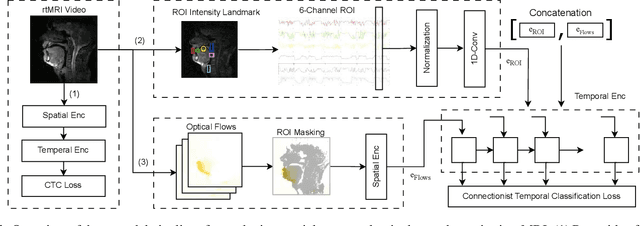
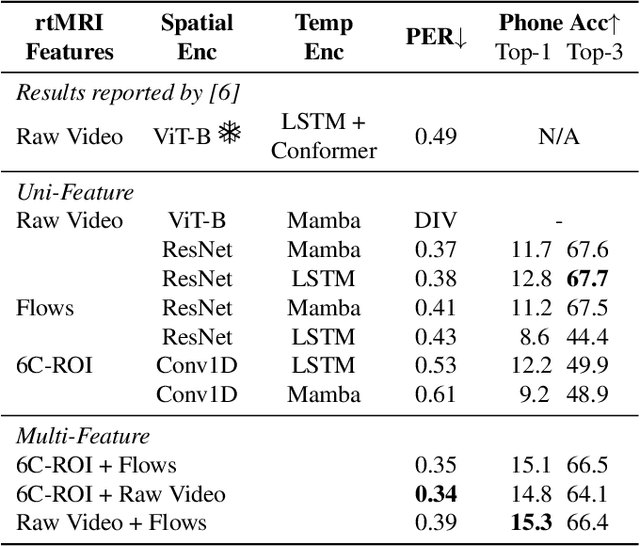


Abstract:Real-time Magnetic Resonance Imaging (rtMRI) visualizes vocal tract action, offering a comprehensive window into speech articulation. However, its signals are high dimensional and noisy, hindering interpretation. We investigate compact representations of spatiotemporal articulatory dynamics for phoneme recognition from midsagittal vocal tract rtMRI videos. We compare three feature types: (1) raw video, (2) optical flow, and (3) six linguistically-relevant regions of interest (ROIs) for articulator movements. We evaluate models trained independently on each representation, as well as multi-feature combinations. Results show that multi-feature models consistently outperform single-feature baselines, with the lowest phoneme error rate (PER) of 0.34 obtained by combining ROI and raw video. Temporal fidelity experiments demonstrate a reliance on fine-grained articulatory dynamics, while ROI ablation studies reveal strong contributions from tongue and lips. Our findings highlight how rtMRI-derived features provide accuracy and interpretability, and establish strategies for leveraging articulatory data in speech processing.
Can Layer-wise SSL Features Improve Zero-Shot ASR Performance for Children's Speech?
Aug 28, 2025Abstract:Automatic Speech Recognition (ASR) systems often struggle to accurately process children's speech due to its distinct and highly variable acoustic and linguistic characteristics. While recent advancements in self-supervised learning (SSL) models have greatly enhanced the transcription of adult speech, accurately transcribing children's speech remains a significant challenge. This study investigates the effectiveness of layer-wise features extracted from state-of-the-art SSL pre-trained models - specifically, Wav2Vec2, HuBERT, Data2Vec, and WavLM in improving the performance of ASR for children's speech in zero-shot scenarios. A detailed analysis of features extracted from these models was conducted, integrating them into a simplified DNN-based ASR system using the Kaldi toolkit. The analysis identified the most effective layers for enhancing ASR performance on children's speech in a zero-shot scenario, where WSJCAM0 adult speech was used for training and PFSTAR children speech for testing. Experimental results indicated that Layer 22 of the Wav2Vec2 model achieved the lowest Word Error Rate (WER) of 5.15%, representing a 51.64% relative improvement over the direct zero-shot decoding using Wav2Vec2 (WER of 10.65%). Additionally, age group-wise analysis demonstrated consistent performance improvements with increasing age, along with significant gains observed even in younger age groups using the SSL features. Further experiments on the CMU Kids dataset confirmed similar trends, highlighting the generalizability of the proposed approach.
* Accepted
Decoding Neural Signatures of Semantic Evaluations in Depression and Suicidality
Jul 30, 2025
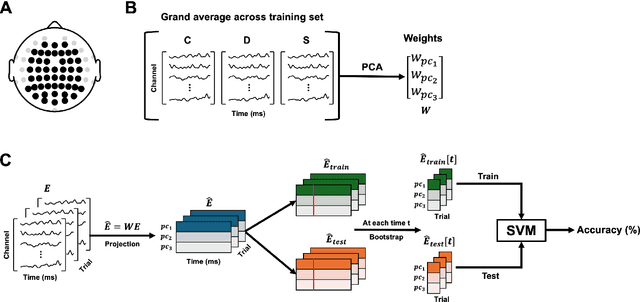
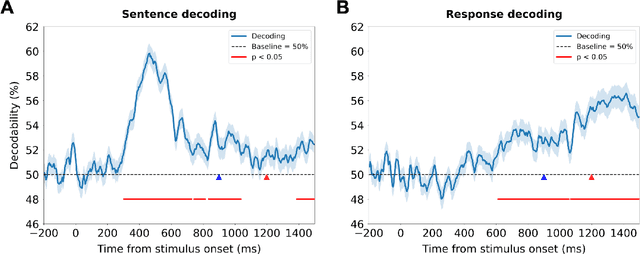
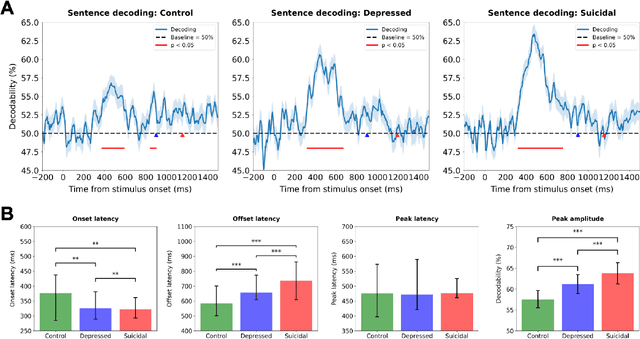
Abstract:Depression and suicidality profoundly impact cognition and emotion, yet objective neurophysiological biomarkers remain elusive. We investigated the spatiotemporal neural dynamics underlying affective semantic processing in individuals with varying levels of clinical severity of depression and suicidality using multivariate decoding of electroencephalography (EEG) data. Participants (N=137) completed a sentence evaluation task involving emotionally charged self-referential statements while EEG was recorded. We identified robust, neural signatures of semantic processing, with peak decoding accuracy between 300-600 ms -- a window associated with automatic semantic evaluation and conflict monitoring. Compared to healthy controls, individuals with depression and suicidality showed earlier onset, longer duration, and greater amplitude decoding responses, along with broader cross-temporal generalization and increased activation of frontocentral and parietotemporal components. These findings suggest altered sensitivity and impaired disengagement from emotionally salient content in the clinical groups, advancing our understanding of the neurocognitive basis of mental health and providing a principled basis for developing reliable EEG-based biomarkers of depression and suicidality.
Developing a High-performance Framework for Speech Emotion Recognition in Naturalistic Conditions Challenge for Emotional Attribute Prediction
Jun 12, 2025Abstract:Speech emotion recognition (SER) in naturalistic conditions presents a significant challenge for the speech processing community. Challenges include disagreement in labeling among annotators and imbalanced data distributions. This paper presents a reproducible framework that achieves superior (top 1) performance in the Emotion Recognition in Naturalistic Conditions Challenge (IS25-SER Challenge) - Task 2, evaluated on the MSP-Podcast dataset. Our system is designed to tackle the aforementioned challenges through multimodal learning, multi-task learning, and imbalanced data handling. Specifically, our best system is trained by adding text embeddings, predicting gender, and including ``Other'' (O) and ``No Agreement'' (X) samples in the training set. Our system's results secured both first and second places in the IS25-SER Challenge, and the top performance was achieved by a simple two-system ensemble.
Joint ASR and Speaker Role Tagging with Serialized Output Training
Jun 12, 2025Abstract:Automatic Speech Recognition systems have made significant progress with large-scale pre-trained models. However, most current systems focus solely on transcribing the speech without identifying speaker roles, a function that is critical for conversational AI. In this work, we investigate the use of serialized output training (SOT) for joint ASR and speaker role tagging. By augmenting Whisper with role-specific tokens and fine-tuning it with SOT, we enable the model to generate role-aware transcriptions in a single decoding pass. We compare the SOT approach against a self-supervised previous baseline method on two real-world conversational datasets. Our findings show that this approach achieves more than 10% reduction in multi-talker WER, demonstrating its feasibility as a unified model for speaker-role aware speech transcription.
Neural Responses to Affective Sentences Reveal Signatures of Depression
Jun 06, 2025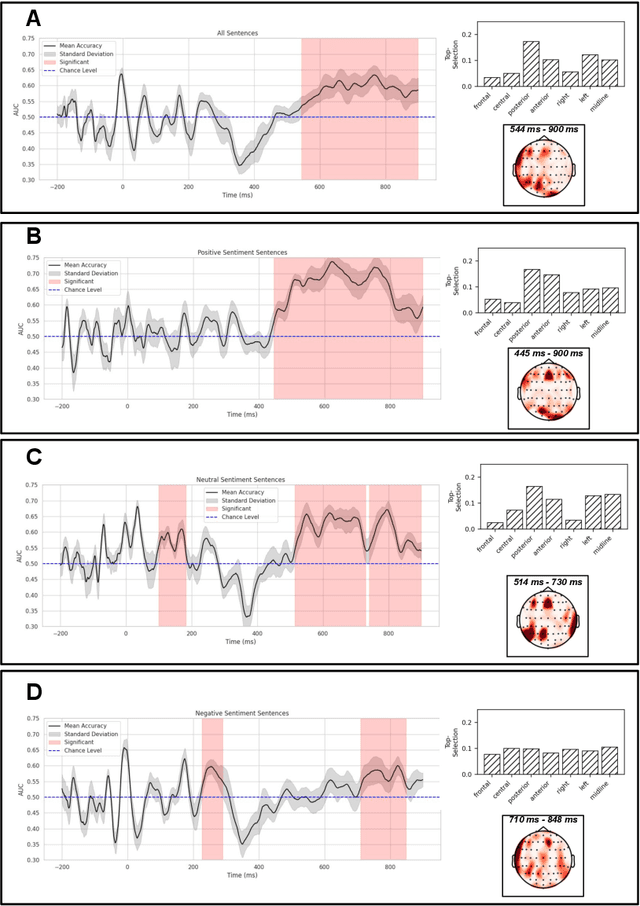
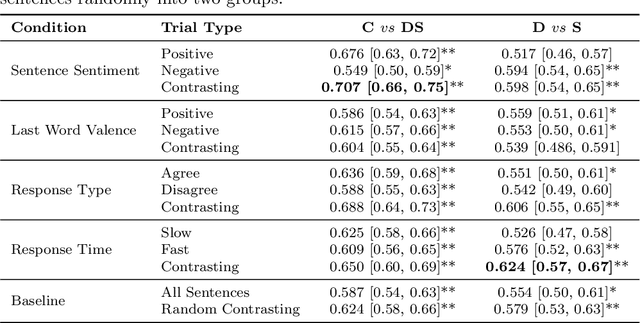
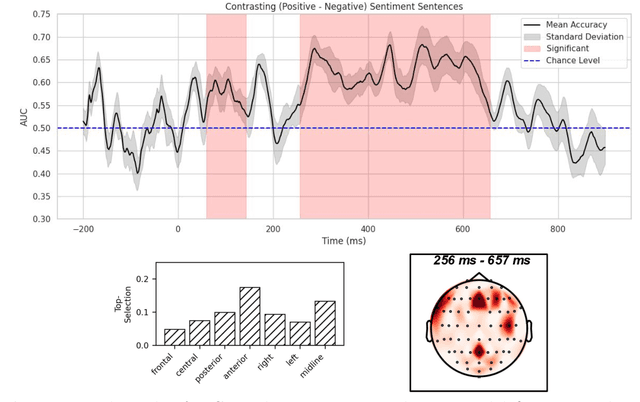

Abstract:Major Depressive Disorder (MDD) is a highly prevalent mental health condition, and a deeper understanding of its neurocognitive foundations is essential for identifying how core functions such as emotional and self-referential processing are affected. We investigate how depression alters the temporal dynamics of emotional processing by measuring neural responses to self-referential affective sentences using surface electroencephalography (EEG) in healthy and depressed individuals. Our results reveal significant group-level differences in neural activity during sentence viewing, suggesting disrupted integration of emotional and self-referential information in depression. Deep learning model trained on these responses achieves an area under the receiver operating curve (AUC) of 0.707 in distinguishing healthy from depressed participants, and 0.624 in differentiating depressed subgroups with and without suicidal ideation. Spatial ablations highlight anterior electrodes associated with semantic and affective processing as key contributors. These findings suggest stable, stimulus-driven neural signatures of depression that may inform future diagnostic tools.
LSM-2: Learning from Incomplete Wearable Sensor Data
Jun 05, 2025



Abstract:Foundation models, a cornerstone of recent advancements in machine learning, have predominantly thrived on complete and well-structured data. Wearable sensor data frequently suffers from significant missingness, posing a substantial challenge for self-supervised learning (SSL) models that typically assume complete data inputs. This paper introduces the second generation of Large Sensor Model (LSM-2) with Adaptive and Inherited Masking (AIM), a novel SSL approach that learns robust representations directly from incomplete data without requiring explicit imputation. AIM's core novelty lies in its use of learnable mask tokens to model both existing ("inherited") and artificially introduced missingness, enabling it to robustly handle fragmented real-world data during inference. Pre-trained on an extensive dataset of 40M hours of day-long multimodal sensor data, our LSM-2 with AIM achieves the best performance across a diverse range of tasks, including classification, regression and generative modeling. Furthermore, LSM-2 with AIM exhibits superior scaling performance, and critically, maintains high performance even under targeted missingness scenarios, reflecting clinically coherent patterns, such as the diagnostic value of nighttime biosignals for hypertension prediction. This makes AIM a more reliable choice for real-world wearable data applications.
 Add to Chrome
Add to Chrome Add to Firefox
Add to Firefox Add to Edge
Add to Edge